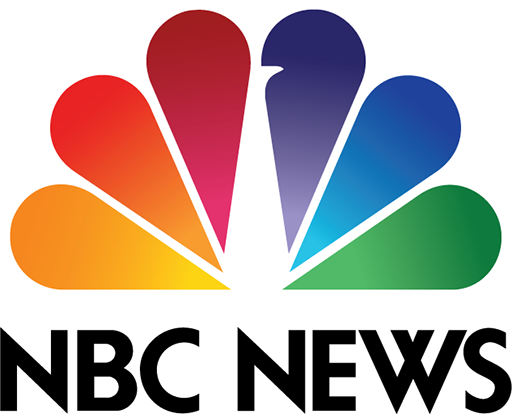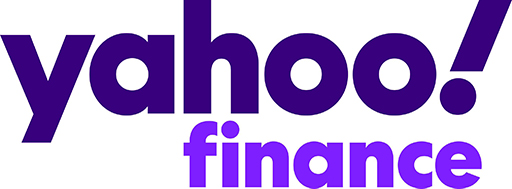Introduction
Our vision is to create a space construction company for the design, manufacture and assembly of large structures in space, including commercial space stations, space solar power platforms, and propellant depots. To achieve this objective, we developed several design patents for in-space assembly robots. We plan to purchase capabilities from other companies as required. To enable a robust, human-centered space economy, our capabilities are geared toward the construction of a Voyager Space Station™ (VSS). We plan to build the rotating space station in stages, starting with a small-scale demonstration station, and one or more free-flying microgravity facilities, utilizing VSS components.
Deal Highlights
- The Future Is In Rotation™. OAC is working to create the first of many large-scale sustainable artificial gravity environments. Other industry players are trying to recreate the International Space Station's 20 year old, microgravity environment.
- OAC is positioned to take advantage of, and dominate, a market that is projected to be worth $147 billion per year within a few years.
- OAC plans to tap into a massive space tourism market that has been repressed by high launch costs for the last 60 years. Because we plan to provide a comfortable and healthy environment using a modular approach at scale, we believe we will be able to offer unparalleled luxury accommodations at a lower cost compared to other commercial stations.
Problem
Large-scale space construction has been limited by the lack of companies with the tools, resources and personnel for assembly of large structures in space. The lack of a permanent work force in space limits the scope and scale of structures able to be constructed. Long-term exposure to the micro-gravity environment in space is proving detrimental to human health. While robotic technology is advancing, a significant capability gap exists between what can be accomplished with robots, whether autonomous or teleoperated, and actual human presence.
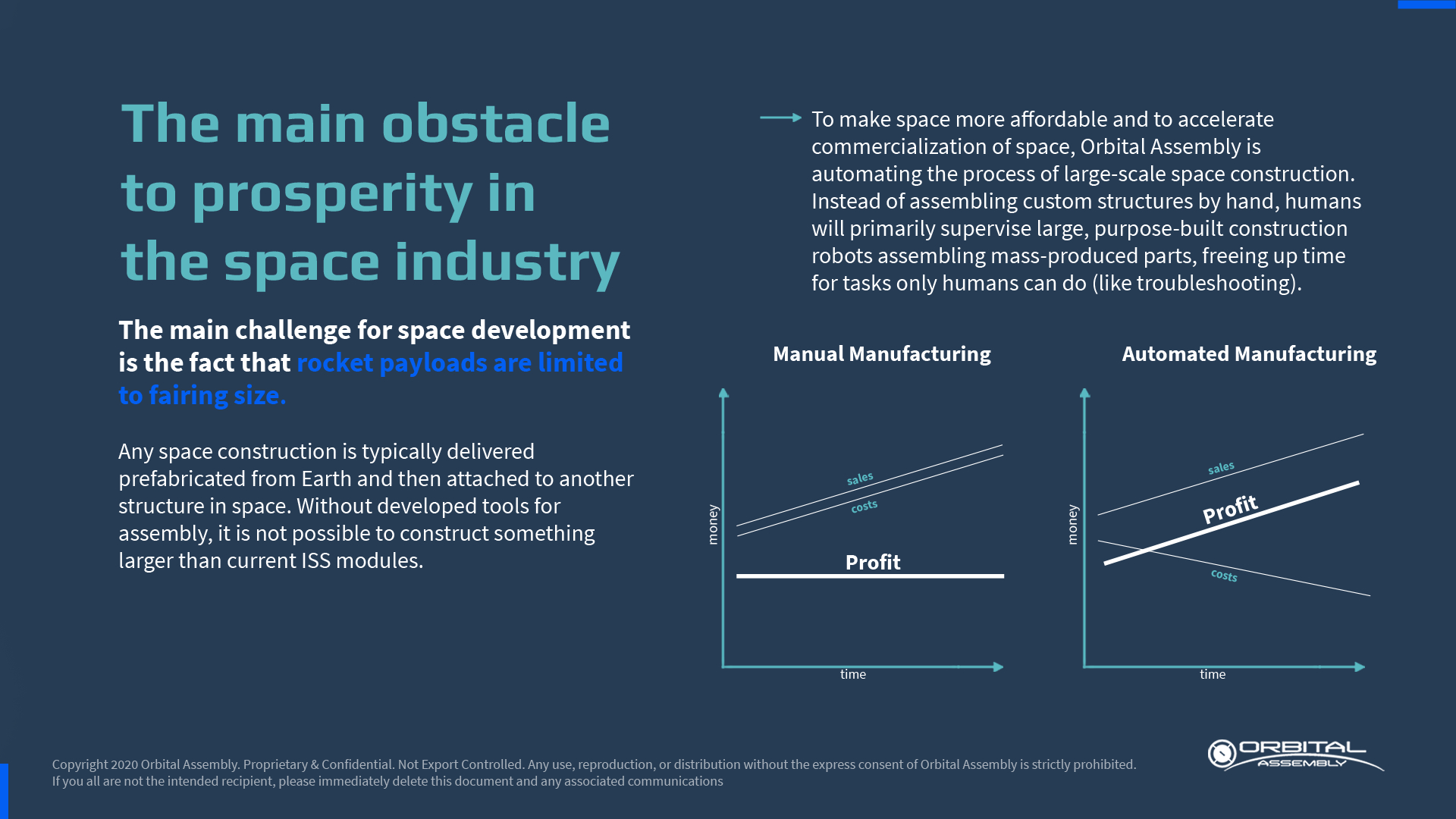
Solution
We developed three design patents for in-space construction robots. We plan to build the Voyager Space Station™, a station with artificial gravity, allowing for a permanent in-space workforce to build and maintain large space structures in a healthy environment. It will employ semi-autonomous and teleoperated robots complemented by spacewalking humans and human-staffed pressurized facilities. Voyager Station will also provide opportunities for researchers, commercial companies, and tourists to access space.
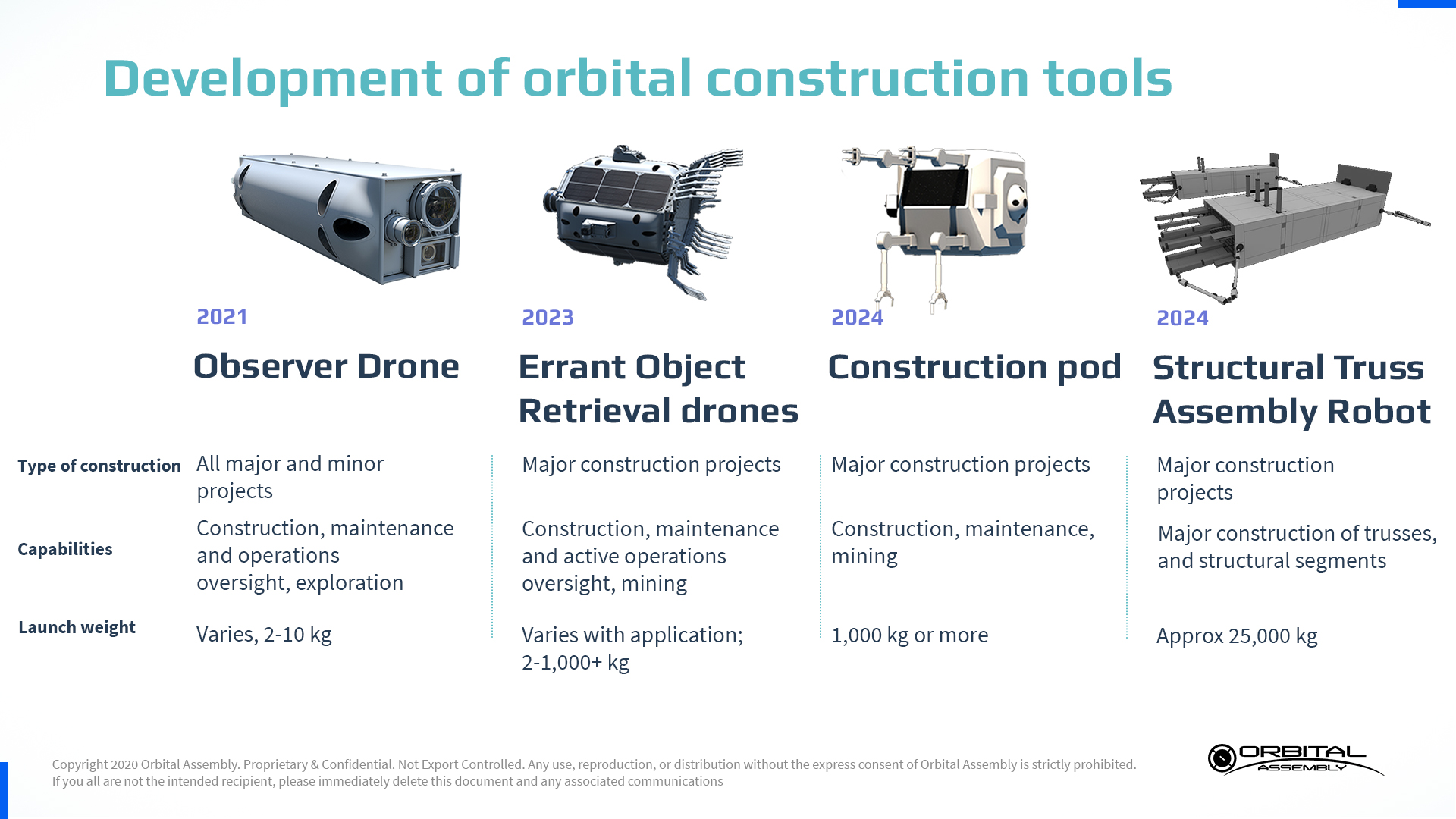
Business Model
The Errant Object Retrieval™ (EOR) drone is anticipated to provide close-proximity operational capability for the assembly of space components by using an image-recognition based artificial intelligence (AI) system to provide autonomous identification and capture recovery of assembly sub-components. OAC plans to design, build, and test the Structural Truss Assembly Robot™ (STAR) — a large, autonomous truss-building machine capable of assembling large-scale (100+ m) linear or circular structures. STAR would work in conjunction with Observer Drone and other assembly robots to build Voyager Station. Prior to launching STAR, OAC plans to launch a prototype version called PSTAR which will build the Gravity Ring™.
The Gravity Ring is a technology demonstration project, which is designed to retire significant technical risk associated with assembling and rotating a large, ring-shaped spacecraft to produce artificial gravity. Measuring 60 m in diameter and rotating at 2.2 rpm to provide lunar-level gravity, the Gravity Ring will be the first spacecraft of its kind deployed, paving the way to larger and more capable spacecraft with artificial gravity, such as Voyager Station™. We expect that NASA and other partners will want to be part of this historic project, as we believe it represents a concrete shift away from microgravity on orbit.
The Gravity Ring is also designed to provide research opportunities for government, academic, and commercial partners alike to fly experiments in a simulated lunar gravity environment in Low Earth Orbit (LEO). Mars-level gravity would be achievable when spun at 3.4 rpm. It’s designed to accommodate numerous experiments that can be attached or detached when not rotating. The Gravity Ring can be spun for weeks or months with one or more experiments on board, allowing for a long baseline data collection. Life science (including animal and human) experiments can be performed with appropriate environmental control and life support systems attached. Propellant mass sufficient for several spin up/spin down cycles and attitude control maneuvers is included in the reference configuration; propellant can be replenished (or additional tanks attached) to extend the operational life of the spacecraft. A straight truss or spokes connecting opposite sides of The Gravity Ring could be attached to provide additional structural rigidity to support heavier structures.
Following PSTAR and The Gravity Ring, we expect to launch the STAR. The STAR will produce superstructure elements for a variety of private industry applications, amortizing its development and operation costs over time through its production queue. The STAR is designed to construct space objects ranging from a few meters on a side to several hundred meters in the long dimension. The full-scale VSS will have a torus-shaped Outer Ring Truss with a diameter of almost 200 meters and a truss cross-section of approximately five meters square. We expect the STAR’s first projects will be Space Power Systems and a 32-meter diameter rigid ring structure that will demonstrate key Voyager Space Station (VSS) capabilities. We anticipate it will serve as the docking hub for the full-scale VSS.
VSS is designed to accommodate a long-term population for 300 visitors (astronauts, scientists, business travelers, long-term residents and tourists) and 100 crew. It would offer artificial gravity as well as microgravity, continuous sunlight providing ample electrical power, comfortable accommodations, quality food and drink, entertainment events, exercise facilities, medical triage services, emergency evacuation capabilities, and stunning views of the earth and stars. The station represents an end-goal-flagship product envisioned by OAC.
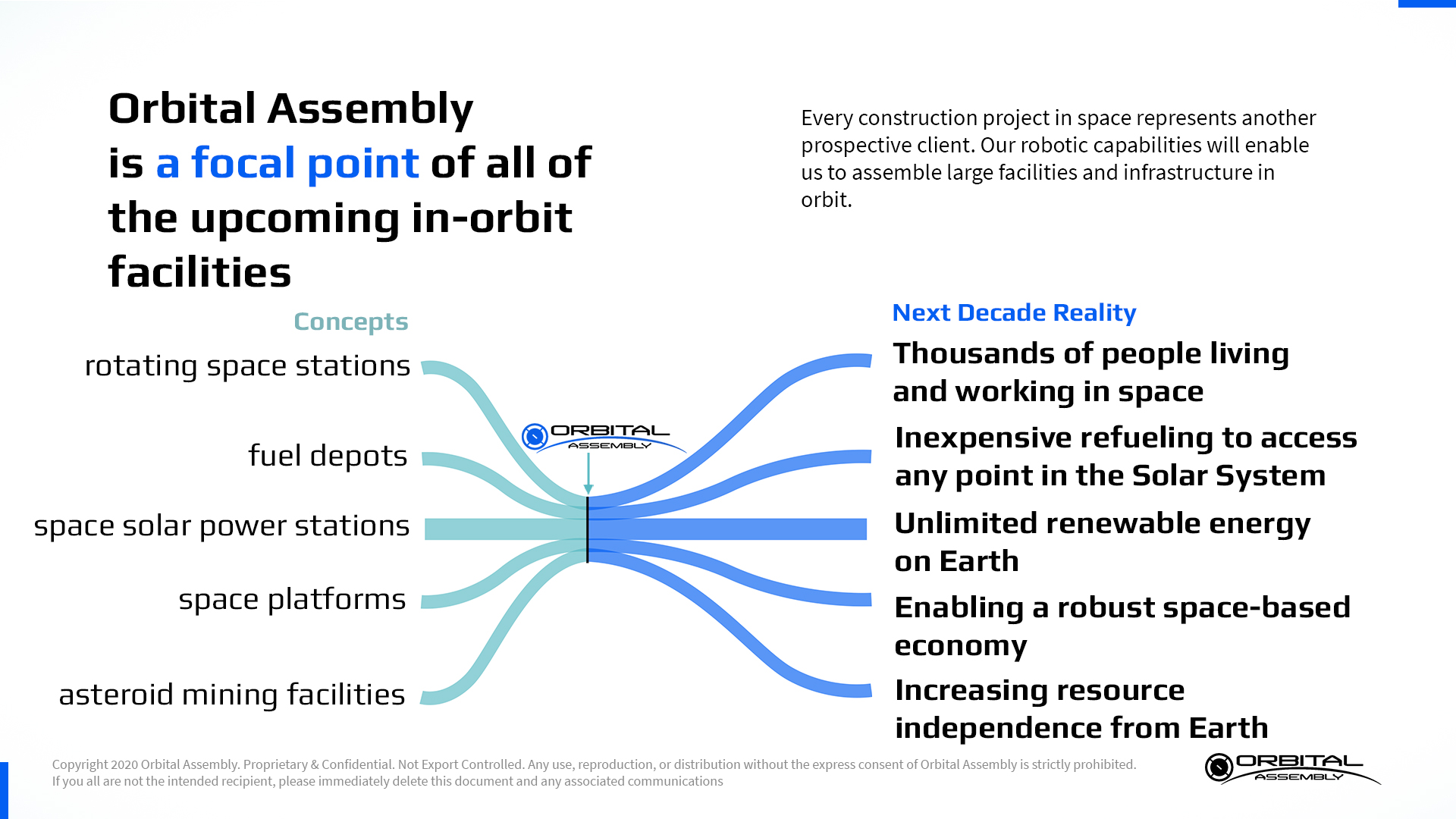
Market
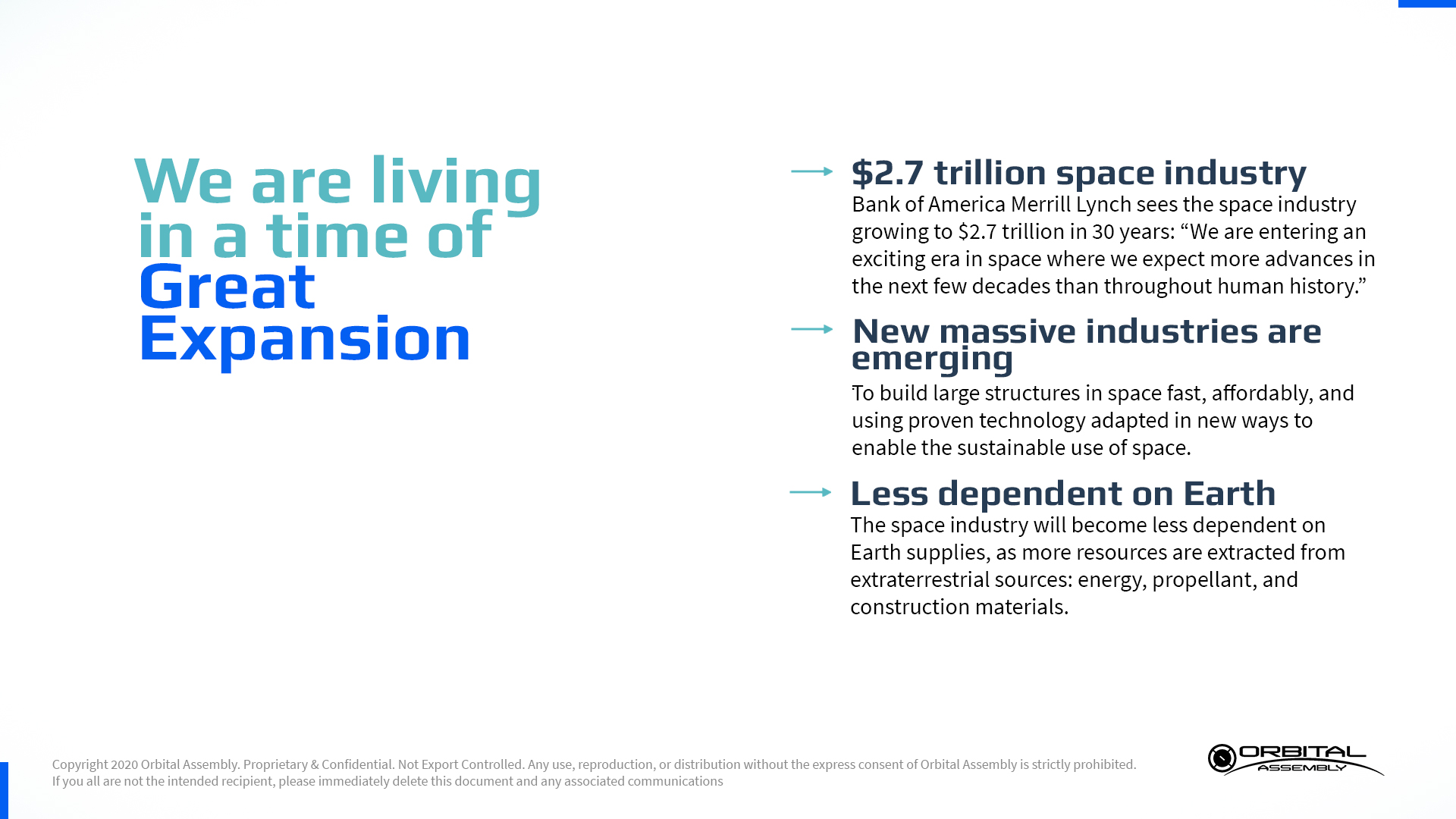

Starting with estimates of the total available market (TAM) and serviceable addressable market (SAM) for each category, we developed estimates of the serviceable obtainable market (SOM) that Orbital Assembly Corp. can hope to achieve for the target year range of 2027-2030. Market estimates for future years could be larger.
We divide our estimate into several components that could have significant market share in LEO in a few years. We estimate our SOM is $147 billion per year. Morgan Stanley recently estimated that the space industry would be worth $490 billion per year by 2027 and $1.1 trillion per year in 2040.
Tourism:
In 2017, the global tourism market was estimated at $5.3 trillion. It is expected to grow to $7.5 trillion per year by 2027, when we expect VSS to be fully operational. This is the Total Available Market (TAM) estimate. Of the total tourism market, we only consider international tourism which represents 26% of the total: Multiply this number by 30% to reflect the fraction of people interested in traveling into space. We recognize that people will not necessarily want every trip to be into space, so we apply a further 20% filter. Virgin Galactic in its recent SEC filing claimed 594 customers had signed up for its 90-minute sub-orbital flight “experience” with a goal to fly more than 3,200 customers by 2023. They assumed an addressable market of 2.4 million individuals with a net worth of $10 million+ in 2023, yielding an early market share of 0.13%. Using the same early market share for VSS but with a required net worth of $48 million+, we estimate an early market of more than 400 customers out of an estimated total population of 301,000 in 2027, based on global wealth distributions, observed spending of the ultra-wealthy, and expected market growth. The superior experience and time duration offered by VSS compared with a sub-orbital flight is expected to increase desirability significantly. We estimate that 7% of the SAM ($40 billion per year) is required to cover the total cost of a fully-functional VSS ($40 billion per year), including transportation. Note that this estimate depends on low per-person and per-kg transportation costs to LEO, fulfilled by SpaceX’s Starship that is in development, or a low-cost, heavy-lift reusable launch vehicle. We believe this market size is realizable due to the distinguishing features of VSS over its competition; It places the SOM at $96 billion per year.
Media, entertainment and advertising:
The global entertainment and media market is projected to grow to $6.7 trillion per year by 2030 (TAM), with the media occupying a tiny share of this total.
Deloitte Consulting in their LEO commercialization study report to NASA last year identified media, advertising, and entertainment as a space industry that could grow significantly, reaching $1.1 billion per year. This estimate was based only on zero-gravity opportunities and not the reduced-gravity facilities of VSS, not to mention the more expansive (and comfortable) environment that could be offered on board. Therefore, we use ~25 times Deloitte’s estimate for our SAM ($28B/yr.), which is 0.4% of the TAM. The superior accommodations on board VSS could make it the go-to location in space for all media-related activities. We feel confident that in the absence of competition, we could capture 95% of this SAM or $27 billion per year.
Life sciences:
Deloitte estimates that life sciences research spending will grow to $1.2 trillion per year by 2022. We expect this TAM to be similar in 2027. Deloitte identified life sciences as a space industry that could grow to a multibillion-dollar market over the next five years, reaching $1.4 billion per year. As for media, entertainment, and advertising, this estimate was based on zero-gravity research conducted on board the ISS. We expect facilities provided on VSS to offer superior mass, volume, and power attributes; the ability to study phenomena in fractional gravity; and unmatched accommodations for scientists. We expect the SAM for life sciences research to be larger, perhaps up to ten times Deloitte’s estimate ($14 billion per year) or ~1% of the TAM. We estimate that the attractive accommodations on VSS could capture up to 90% of the SAM, or ~$13 billion per year.
Global electricity system:
We estimate the size of the global electricity market in 2030 as $4.3 trillion per year based on demand of 33,000 TWh/yr and an average global electricity price of $0.13 per kWh. If energy is provided in space via solar power satellites, in-space construction might save 10% (see space telescopes below), resulting in a TAM of $430 billion per year. Space solar power could play a role in the global electricity system by 2030, though it is unlikely to contribute more than a small fraction by this time. We estimate a maximum contribution of 0.25% (~10 GW) to global electricity production for in-space construction (SAM = ~$1.0 billion per year), though it could grow in future years. Competing methods of assembling solar power satellites in space might not allow OAC to capture the entire market, but we think it could constitute up to 50% of the SAM or ~$540 million per year.
Power electronics:
This technology is difficult to improve upon on Earth but silicon carbide semiconductors, which can only be made at a higher efficiency in microgravity, could cut power losses by 8% in electric motors and 1.5% in solar photovoltaic (PV) converters. Electric motors consume a staggering 45% of global electricity consumption, and solar PV could in principle provide all global electricity (whether located on the ground or in space). Using the estimate for the size of the global electricity market in 2030, savings translate into a TAM of $220 billion per year. While there are challenges with silicon carbide production, it is possible that this industry could ramp up quickly, perhaps reaching 1% of its potential in 2027 (SAM = $2.2 billion per year). Large-scale manufacturing will require human workers to maintain and troubleshoot equipment. A free-flying microgravity facility module, manufactured by OAC, adjacent to VSS, will be an ideal manufacturing location that could capture 90% of the SAM or $2.0 billion per year.
Telecommunications:
Another class of products with superior properties when produced in microgravity is exotic glasses and fibers, exemplified by ZBLAN fiber optic that boasts much lower losses than Earth-made materials. The size of the global fiber optic market is projected to grow to $11.7 billion in 2025, and $14.5 billion in 2027 (TAM). All this fiber could be made in space; ZBLAN fiber could scale more quickly than silicon carbide, perhaps reaching 10% of its ultimate market by 2027 or $1.5 billion per year (SAM). As for silicon carbide, large-scale manufacturing will also require human workers for maintenance and troubleshooting, making an OAC-built facility ideal for manufacturing.We believe we could capture 90% of the SAM or $1.3B/yr.
Propellant depots:
We use a Booz Allen Hamilton estimate of ~3,750 kg per year water propellant per large military-class satellite (which constitutes 7% of all current satellites) and are resupplied with in-space propellant at a value of $3,000 per kg estimated by ULA. With increasing satellite launches to 2,000 per year, in 2030, this constitutes a market of $1.6 billion per year. There could be significant additional demand from de-orbiting of LEO satellites, such as what OrbitFab is planning to do. We estimate that if the number of defunct LEO satellites increases to 2,000 per year by 2030, at $1.5 million per satellite, this market could grow to $3.0 billion per year. If large-payload spacecraft such as SpaceX’s Starship or Blue Origin’s New Armstrong are flying regularly by 2027, in-orbit refueling demand could dwarf these other uses; we estimate that 12 annual Starship refuelings would require 14,400 t of methane/oxygen propellant, or $43 billion per year, if valued at $3,000 per kg It’s likely the price of propellant will drop significantly once Starship begins flying. We estimate a future propellant cost of $300 per kg. The TAM is estimated to be $7.5 billion per year, and perhaps up to 10% of satellites might be serviced using propellant depots by 2027, and 100% of Starship-class rockets leaving LEO, so the SAM is ~$4.6 billion per year. While propellant depots could compete with OAC, we expect to capture up to 70% of the SAM or $3.2 billion per year.
Deep space communications network:
NASA maintains a trio of ground stations for communicating with spacecraft more than 2 million km away. This ground network has been historically sufficient, but demand is projected to grow by 26% per year over the next three decades. Based on hourly usage fees, we estimate the current value of the network is $553 million per year growing to $5.5 billion per year by 2030 (TAM). If the next-generation deep space network is built in space by 2030, it could provide >90% of total future capacity (SAM = $5.0 billion per year). To build radio antennas in space with larger diameters (100-200 m) than the current ground stations, it will require OAC capabilities.We expect that OAC could capture >90% of the SAM or $4.5 billion per year.
Space telescopes:
The 6.5 m dia. James Webb telescope planned for launch in 2021, at a total cost of $10 billion, is expected to be 100 times better than the Hubble Space Telescope. Based on space telescope cost-scaling relationships, we estimate that the 15 m dia. Large Ultra-VioletOptical Infra-Red (LUVOIR) telescope planned for 2039 could cost $26 billion. In-space assembly could reduce costs by ~10%. If constructed in space, assuming an estimated lifetime of 20 years ($3.6 billion per year), we estimate the TAM to be equal to the existing and proposed Earth- and space-based optical telescope ≥3 m dia. (Note that radio telescopes were not included in this estimate.) Perhaps one space telescope could be assembled in the 2027-2030 time frame using in-space construction techniques, which is about 1.4% of the total estimate, or $50 million per year (SAM). If such structures are constructed, they will be built using OAC equipment and personnel.We expect to capture >90% of this SAM or ~$50M/yr. Note that radio telescopes were not included in this estimate, but it would also be possible to construct large space-based radio telescopes, for instance as a replacement for the Arecibo telescope.
Progress
OAC has compiled a world class team of engineers, scientists, architects, designers, business professionals, and physicians. The DSTAR (Demonstration Station Truss Assembly Robot) is under construction with a ground demonstration planned for Q1, 2021, when we will build a football field length of truss in 90 minutes.
- The EOR program is underway with significant design progress on our Observer Drone.
- Architectural designs for Voyager Station and Voyager Alpha (a free-flying space station based on VSS components) have been completed.
- Gravity Ring and PSTAR design is underway with a planned launch by 2023.
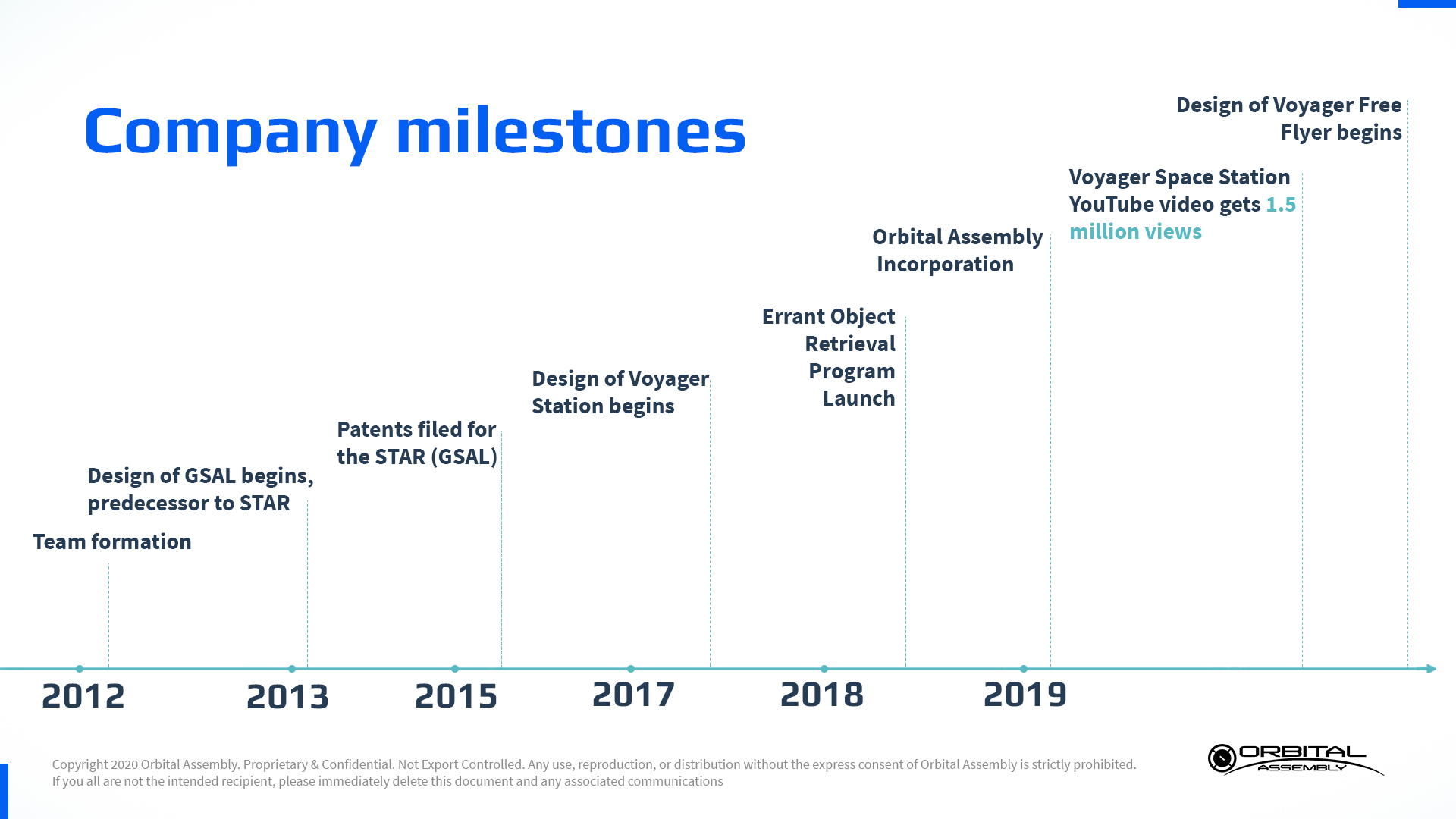

Press
We’ve had over 200 media mentions around the world. For more, visit https://orbitalassembly.com/news
Team
Our team comprises world class experts, each with decades of experience in the fields of construction, design, engineering, physics, space architecture, space craft, space mission design, and business. Our team of experts possess a multitude of unique talents, experiences, and knowledge that position us for immediate and long term success.
John Blincow is President of the Gateway Foundation and CEO of Orbital Assembly Corporation. John founded the Gateway Foundation in October of 2012 and has three patents for space construction machines designed to build large frames quickly. John has spoken about the creation of Spaceports at Caltech, Stanford, and the AIAA. Before forming the Gateway Foundation, John worked as a pilot for 24 years, flying all over the world in such aircraft as the Boeing 757, DC-10, and Boeing 747-400. John’s experience as a pilot instructor includes United Airlines, Boeing Flight Safety, and as a Check- Point Security instructor for The Transportation Security Administration (TSA) during its formation.
Dr. Thomas R. Spilker received his Ph.D. in Electrical Engineering from Stanford University's Space Telecommunications and Radio Science Laboratory in 1990. From there he spent two years at the Jet Propulsion Laboratory as a National Research Council Resident Research Associate, then hired on as a full-time Member of Technical Staff at JPL. He remained there until early retirement in 2012, attaining the position of Principal Mission Architect. Since his retirement he has worked as an independent consultant in space flight mission architecture and a planetary atmospheric scientist. He participated in NASA's Voyager, Cassini, and Genesis missions, and was a science Co-Investigator on JPL's MIRO instrument on the European Space Agency's Rosetta mission. Dr. Spilker began working with the Gateway foundation in 2015. He is currently its Chief Architect and is the Vice President of Orbital Assembly Corporation.
Tim received a Bachelor of Architecture degree from Cal Poly, San Luis Obispo. He has traveled extensively and has lived abroad in Europe. Tim is the CEO and principal architect of Domum, a multi award-winning northern California based architecture firm recently ranked as the number two architecture firm in California. After decades of research Tim developed the Domum Delivery Method™ which leverages the “experience of home” to create designs which yields high financial and lifestyle benefits for his clients. His systems and methods have been successfully applied to the development of the Voyager class of space stations which has received world-wide attention. Tim has been featured in ArchDaily, DeZeen, GQ Magazine, The Moncrieff Show, The Newsroom BBC World, the Space Channel, and many other prominent design and media outlets around the world. Tim consults for the State of California Architects Board as a Subject Matter Expert and currently serves on the Architectural Review Committee and as Chairman of the Planning Commission with the City of Rocklin, CA.
Mr. Wolff is an attorney and entrepreneur, developing a corporate portfolio of innovative and cutting edge startup companies including 3D printing technology, robotics, commercial space, and more. Mr. Wolff is admitted to the Appellate Division, First Department of New York State. He is a graduate of Johns Hopkins and New York Law School. He is an attorney in the Commercial and Real Estate Litigation Department of Sacco & Fillas LLP. He is also a volunteer Executive Board Member At- Large for the United Nations Association, serving on the Southern District Division of New York committee. He has lectured on emerging technologies at institutions such as the New York City Bar Association, MIT, the New York County Lawyers Association, the Westchester Bar Association, The New York State Society of Certified Professional Accountants Litigation committee, and more. His portfolio includes companies such as co-founding Deep Space Industries, headquartered in NASA Ames in California, Space Initiatives Inc., headquartered in Florida, United Frontiers, headquartered in Florida, and Immortal Data, headquartered in Virginia where he serves as Chief Financial Officer.
Dr. Jeffery Greenblatt has a Ph.D. in chemistry from the University of California, Berkeley, and is a well-known expert in the fields of energy analysis, climate policy and sustainable transportation, with almost 20 years’ experience. Since 2014, he has expanded his focus to include emerging space technologies, and founded Emerging Futures, LLC, an environmental and space technology consultancy, in 2016. He joined Orbital Assembly Corporation in 2019, where he serves as Chief Scientist as well as Chief Visionary Officer. He is also Chief Scientist at Spacexchange, LLC, an economic, risk and market analytics consultancy to the Space industry. In addition to its ongoing Earth-focused strategy and modeling work, Emerging Futures has been developing models of complex, interconnected space ecosystems that span human life support, in-situ resource utilization and logistics for the Moon, Mars and orbital locations. Previous and current clients include the California Council on Science and Technology, Deloitte Consulting, Energy Innovation LLC, Lawrence Berkeley National Laboratory, Midcontinent Independent System Operator, NASA, Opus 12, Inc., Rocky Mountain Institute, University of California, Berkeley and an undisclosed private space company. Previously, Jeff served as Staff Scientist at Lawrence Berkeley National Laboratory for over 8 years, and he has also worked in research and leadership capacities at Google, Environmental Defense Fund, Princeton University and NASA Ames Research Center.
Robert N. Miyake received a BS in Mechanical Engineering from San Jose State College, with a thermal/fluids and nuclear emphasis, with additional graduate studies in mathematics, bio-engineering, system engineering and computer science. His first position after graduation was with the Boeing Airplane Company in the design of the 727 aircraft. After Boeing, he had a position with the Lockheed Missiles and Space Company which was in the design-fabrication-flight operations for Air Force and NASA spacecraft, as well as for Earth surface and ocean systems design. He was a Member of the Technical Staff at the Jet Propulsion Laboratory supporting thermal and system design-fabrication- launch and flight operations for NASA science instruments and spacecraft. He was a lead team member for developing technology requirements and flight systems for future missions. He retired from the Jet Propulsion Laboratory in 2011. After his retirement, he began working with the Gateway Foundation and is currently the thermal and systems engineer.
Advisors and Investors
Physician, Speaker, Citizen-Scientist Astronaut & Aquanaut, Martial Artist
Chairman of the board of the Tau Zero Foundation
President / CEO of Space Mining and Resources Coalition,
CEO of Blue Elysium Capital Group
creative director and impressario
Use of Proceeds
If the offering's maximum amount of $1,000,000 is raised:
| Use | Value | % of Proceeds |
|---|---|---|
| Compensation for managers | $250,000 | 25.0% |
| DSTAR Demonstration - Warehouse rental | $70,000 | 7.0% |
| DSTAR System components | $8,000 | 0.8% |
| PSTAR and Gravity Ring Engineering and Prototype | $250,000 | 25.0% |
| PSTAR and Gravity Ring Fabrication | $311,000 | 31.1% |
| Observer Drone Development | $50,000 | 5.0% |
| Observer Drone Fabrication | $12,000 | 1.2% |
| Intermediary fees | $49,000 | 4.9% |
Terms
This number includes all funds raised by the Company in this round on Netcapital. This is an offering of Common Stock, under registration exemption 4(a)(6), in Above: Space Development Corporation dba Orbital Assembly. This offering must reach its target of at least $10,000 by its offering deadline of April 22, 2021 at 12:59am ET. If this offering does not reach its target by the offering deadline, then your money will be refunded.
If the offering is successful at raising the maximum amount, then the company’s implied valuation after the offering (sometimes called its post-money valuation) will be:
Pitch Deck
Financials
Orbital Assembly’s official name is Above: Space Development Corporation, so that’s the name that appears in the statements below.
These financial statements have been audited by an independent Certified Public Accountant.
SEC Filings
The Offering Statement is a formal description of the company and this transaction. It’s filed with the SEC to comply with the requirements of exemption 4(a)(6) of the Securities Act of 1933.
We’re also required to share links to each of the SEC filings related to this offering with investors.
Understand the Risks
Be sure to understand the risks of this type of investment. No regulatory body (not the SEC, not any state regulator) has passed upon the merits of or given its approval to the securities, the terms of the offering, or the accuracy or completeness of any offering materials or information posted herein. That’s typical for Regulation CF offerings like this one.
Neither Netcapital nor any of its directors, officers, employees, representatives, affiliates, or agents shall have any liability whatsoever arising from any error or incompleteness of fact or opinion in, or lack of care in the preparation or publication of, the materials and communication herein or the terms or valuation of any securities offering.
The information contained herein includes forward-looking statements. These statements relate to future events or to future financial performance, and involve known and unknown risks, uncertainties, and other factors, that may cause actual results to be materially different from any future results, levels of activity, performance, or achievements expressed or implied by these forward-looking statements. You should not place undue reliance on forward-looking statements since they involve known and unknown risks, uncertainties, and other factors, which are, in some cases, beyond the company’s control and which could, and likely will, materially affect actual results, levels of activity, performance, or achievements. Any forward-looking statement reflects the current views with respect to future events and is subject to these and other risks, uncertainties, and assumptions relating to operations, results of operations, growth strategy, and liquidity. No obligation exists to publicly update or revise these forward-looking statements for any reason, or to update the reasons actual results could differ materially from those anticipated in these forward-looking statements, even if new information becomes available in the future.
More Info
Updates
- Jan 24, 2023Orbital Assembly Names Ascent Solar CEO Jeffrey...
- Dec 15, 2022New research study - live now! In partnership...
- Dec 12, 2022New Question and Answer call with CTO, Dr. Tom...
- Dec 9, 2022Orbital Assembly announces a new program and...
- Nov 28, 2022Invitations were just emailed out for our...
- Nov 22, 2022Message for our Investors on the Netcapital...
- Oct 12, 2022# Hello! If you haven't signed up for our email...
- Jul 19, 2022Special video call for our premium...
- May 16, 2022Claim your investor gifts before the July 31st...
- May 10, 2022Tonight between 7:30pm and 8:00pm ET, COO Tim...
- Apr 30, 2022Primary offering finalized, selling shares
- Apr 26, 2022The OAC Executive team would like to extend our...
- Apr 19, 2022It is with great excitement that we welcome...
- Apr 12, 2022We are excited to announce our partnership with...
- Apr 8, 2022We have launched a new show, "Our Future In...
- Apr 6, 2022In case you missed it. New Q&A with COO Tim...
- Mar 25, 2022Last week we emailed you about our first ever...
- Mar 23, 2022Orbital Assembly Corporation is relocating its...
- Mar 22, 2022Orbital Assembly Congratulates Chief of Medical...
- Mar 18, 2022Orbital Assembly has launched our first ever...
- Mar 11, 2022Orbital Assembly's COO, Tim Alatorre, did a...
- Feb 4, 2022Did you know? In the summer of 2021 we...
- Feb 2, 2022In the last 12 months OAC has had 2 successful...
- Jan 31, 2022OAC is constantly in the news. We want to keep...
- Jan 28, 2022Greetings: Here is the second of the two-part...
- Jan 26, 2022Greetings: We wanted to share the first of a...
- Jan 24, 2022We are nearing $1M in our second raise and...
- Jan 13, 2022OAC is pleased to be featured on e360tv this...
- Jan 11, 2022Dear OAC supporters: Many of you have already...
- Nov 30, 2021# We are excited to announce passed...
- Nov 9, 2021If you are an investor we would love to say...
- May 25, 2021Orbital Assembly Corporation is excited to...
- Apr 22, 2021Primary offering finalized, selling shares
- Jan 29, 2021Today we will be holding a virtual event at 1pm...
Ask a Question
Proofread your comment before submitting: once it's posted, you can’t edit or delete it. Investors are advised to review our Discussion Board Policy before submitting a comment. For the fastest help with the web site, email help@netcapital.com instead of commenting.
Looking to raise capital?
We can help turn your friends, family and customers into investors.
Interested in more investment opportunities?
Browse all offerings currently available.





